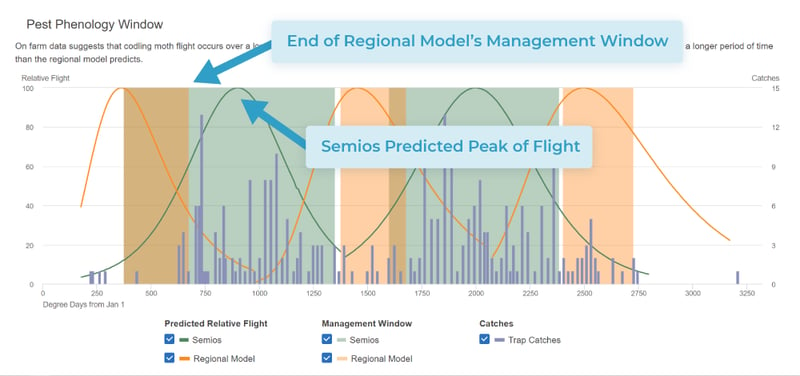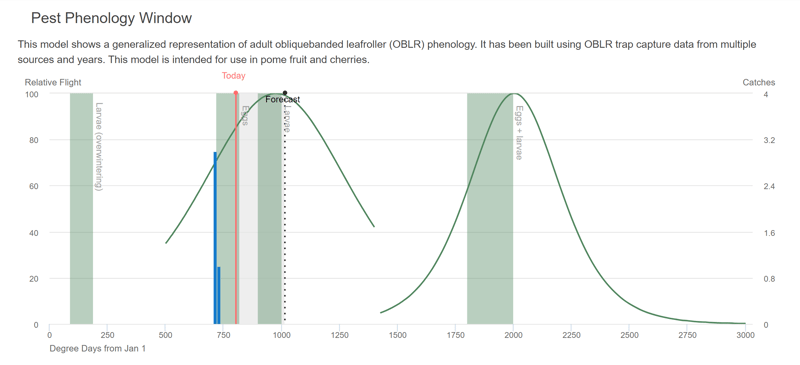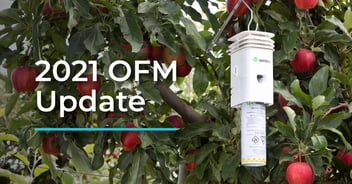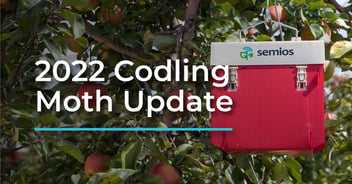2023 Washington Codling Moth & Obliquebanded Leafroller Update
Wondering how codling moth and obliquebanded leafroller development is looking so far in Washington?
Here's a quick pest update based on what we're observing from the Semios network of camera traps and weather stations, followed by tips on actions you can take now as part of your pest management program.
Jump to a section:
Codling Moth Update
As of June 9th, the warmest locations in our network are at around 850 degree days.
You can refer to WSU's resource on How to Effectively Manage Codling Moth for guidance on treatment timings based on your current degree days.
1. Check your on-site degree days
Based on your current degree days and your 15-day forecast on Semios, plan your treatment timings using guidance from WSU.
Remember that your on-site weather station is much more reliable for pest insights than a regional/public weather station, and should be your go-to data source.
2. Check your unique codling moth pest phenology window
 The codling moth phenology page on the Semios platform where users can view suggested management windows and predicted flights based on the regional WSU model and a site-specific Semios model.
The codling moth phenology page on the Semios platform where users can view suggested management windows and predicted flights based on the regional WSU model and a site-specific Semios model.
Plan ahead with the help of a codling moth degree-day model.
Semios users can go to their Codling Moth Pest Phenology Page to track predicted codling moth flights based on their unique in-canopy weather data. You’ll see the regional WSU model (in orange) for predicted flights and suggested management windows.
Users with 2+ seasons of Semios pest data will also see their site-specific Semios flight model (in green) which is driven by their unique in-canopy climate and pest development observations.
⚠ What to look out for this year
We have seen many front-heavy flights which likely corresponds to the early warm weather in May.
Stay diligent - watch your traps and set alert thresholds. We know codling moth can have protracted flights that extend past regional management windows, such as in the example above.
Obliquebanded Leafroller Update
- We started catching for obliquebanded leafroller in our trapping network around May 19th, 2023.
- Since then, trap captures started to pick up at the end of May into June.
- During June 6-8, we've seen an uptick in captures in Grant and Adams County.
1. Scout for leafroller larvae
Be sure to scout for leafroller larvae as you may still encounter obliquebanded leafroller damage from the overwintering generation. However, any larvae you find now are likely from the 1st generation.
Semios users can use Scout on the Semios mobile app to take GPS-tagged photos and field notes to share with their team.
2. Check your obliquebanded leafroller pest phenology window
 Example of the obliquebanded leafroller phenology model on the Semios platform. The green sections show suggested management periods for the pest. The green curves indicate predicted flights, with the maximum height of the curve showing predicted peak flight.
Example of the obliquebanded leafroller phenology model on the Semios platform. The green sections show suggested management periods for the pest. The green curves indicate predicted flights, with the maximum height of the curve showing predicted peak flight.
Based on the Semios obliquebanded leafroller phenology model, we are currently in the first flight.
Semios users can go to their Obliquebanded Leafroller Pest Phenology Page to view suggested management periods for their site. Refer to guidance from WSU on how to use these treatment windows when planning sprays.



.jpg?width=352&name=_MG_4127%20(1).jpg)

